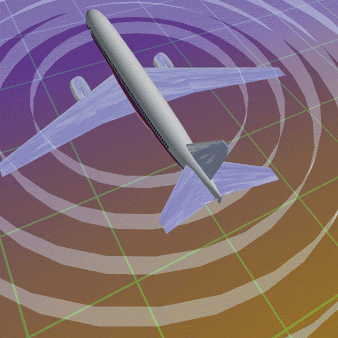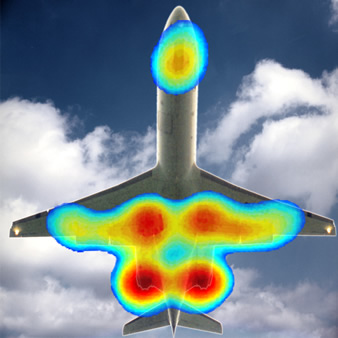Aircraft noise is defined as sound produced by any aircraft on run-up, taxiing, take off, over-flying or landing.
Aircraft noise is a significant concern for approximately 100 square kilometers surrounding most major airports. Aircraft noise is the second largest (after roadway noise) source of environmental noise. While commercial aviation produces the preponderance of total aircraft noise, private aviation and military operations also play a role. It is usually measured in Decibels.
Take-off of aircraft may lead to a sound level of more than 100 decibels at the ground, with approach and landing creating lower levels. Since aircraft landing in inner-city airports are often lower than 60 meters above roof level, a sound level above 100 dBA can be realized.
Mechanisms of sound production
A moving aircraft including the jet engine or propeller causes compression and rarefaction of the air, producing motion of air molecules. This movement propagates through the air as pressure waves. If these pressure waves are strong enough and within the audible frequency spectrum, a sensation of hearing is produced. Different aircraft types have different noise levels and frequencies. The contributions to the total noise level originate from three main sources:
Aerodynamic noise
Engine and other mechanical noise
Noise from aircraft systems
Aerodynamic noise
Aerodynamic noise arises from the airflow around the aircraft fuselage and control surfaces. This type of noise increases with aircraft speed and also at low altitudes due to the density of the air. Jet-powered aircraft create intense noise from aerodynamics, which is typically broadband. Low flying, high speed military aircraft produce especially loud aerodynamic noise. Even though cabin sound levels may be lower in civilian commercial airliners due to added sound attenuating material, it should be noted that this exposure can lead to damage, since hearing loss is cumulative.
The shape of the nose, windshield or canopy of an aircraft can greatly affect the sound produced. Much of the noise of a propeller aircraft is of aerodynamic origin due to the flow of air around the blades. The helicopter main and tail rotors also give rise to aerodynamic noise. This type of aerodynamic noise is mostly low frequency determined by the rotor speed.
Engine and other mechanical noise
Much of the noise in propeller aircraft comes equally from the propellers and aerodynamics. Helicopter noise has a unique spectral content, essentially being aerodynamically induced noise from the main and tail rotors and mechanically induced noise from the main gearbox and various transmission chains. The mechanical sources produce narrow band high intensity peaks relating to the rotational speed and movement of the moving parts. In computer modelling terms noise from a moving aircraft can be treated as a line source.
Noise from aircraft systems
Cockpit and cabin pressurisation and conditioning systems are often a major contributor within cabins of both civilian and military aircraft. However, one of the most significant sources of cabin noise from commercial jet aircraft other than the engines is the Auxiliary Power Unit (or APU). An Auxiliary Power Unit is a relatively small self contained generator used in aircraft to start the main engines, usually with compressed air, and to provide electrical power while the aircraft is on the ground. The typical noise output of an APU is 113 decibels. This is about 27 decibels lower than that of a jet engine. Other internal aircraft systems can also contribute, such as specialised electronic equipment in some military aircraft.
Annoyance effects
Lesser intensities of noise are produced for cruising velocities, mainly due to the altitudes of operation. However, this noise often is heard in country settings which are by nature very peaceful. Thus the intrusion of this type of noise can be very intrusive even if much less in amplitude (say approximately 45 decibels). Landing aircraft descend on a three degree glide path towards an aiming point approximately 300 meters from the runway threshold. This places them at 60 meters above the ground at about 1200 meters from the aiming point or 900 meters from the start of the runway. This distance is usually outside the airport fence. Departing aircraft normally are over 150 meters above the ground before crossing the end of the runway.
Health effects of aircraft noise
Main article: Noise health effects
The annoyance effects of aircraft noise are widely recognized; however, aircraft noise is also responsible for a significant amount of hearing loss as well as a contributor to a number of diseases. Only in the early 1970s did aircraft noise become a widespread topic of concern in the U.S. and federal regulations began to recognize the significance of abating these impacts in the vicinity of major commercial airports. High levels of aircraft noise that commonly exist near major commercial airports are known to increase blood pressure and contribute to hearing loss. Some research indicates that it contributes to heart diseases, immune deficiencies, neurodermatitis, asthma and other stress related diseases. Further research is being carried out to better understand these effects.
Prior research indicates clearly that hearing loss is less a product of aging than a result of exposure to transportation related noise (Rosen, 1965). Any sound louder than normal conversation can damage the delicate hair cells in the cochlea, the structure in the inner ear that converts sound waves into auditory nerve signals. Initially damage to the cochlea may be temporary, but with repeated exposure, the damage becomes permanent and tinnitus maybe develop. More recently the Centers for Disease Control and Prevention's (CDC) National Center for Environmental Health (NCEH) conducted an analysis to determine the prevalence of hearing loss among children using data collected from 1988-1994 in the Third National Health and Nutrition Examination Survey. The analysis indicates that 14.9% of U.S. children have low or high frequency hearing loss of at least 16 dB hearing level in one or both ears.
From research of the National Institutes of Health, roughly 65 million Americans are exposed to sound levels that can interfere with their function at work or disrupt sleep, and 25 million are exposed to health risk (cardiovascular, immunological, etc.) from environmental noise.
Noise mitigation programs
Main article: Noise mitigation
In the United States, since aviation noise became a major public issue in the late 1960s, governments have enacted legislative controls. Aircraft designers, manufacturers, and operators have developed quieter aircraft and more careful operating procedures. Modern high-bypass turbofan engines, for example, are quieter than the turbojets and low-bypass turbofans of the 1960s. First, FAA Aircraft Certification achieved noise reductions classified as 'Stage 3' aircraft; which has been upgraded to 'Stage 4' noise certification resulting in significantly quieter aircraft. This has resulted in lower noise exposures in spite of increased traffic growth and popularity.
In the 1980s the U.S. Congress authorized the FAA to devise technology and programs to attempt to insulate homes near airports. While this obviously does not address the exterior environment, the program has been effective for residential interiors. Some of the first airports at which the technology was applied were San Francisco International Airport and San Jose International Airport in California. The underlying technology is a computer model which simulates the impingement of aircraft noise upon building structures. One can examine variations in aircraft types, flight patterns and local meteorology. then one can evaluate the benefits of alternative building retrofit strategies such as roof upgrading, window glazing improvement, fireplace baffling, caulking construction seams and other measures. The computer model allows cost effectiveness evaluations of unlimited numbers of strategy combinations (Hogan, 1984).
Another possible solution is the development of floating airports which would be situated many miles out to sea, where planes could take off and land without disturbing communities below. However, there are considerable drawbacks to this solution including significant expense, time and inconvenience to travelers in reaching an airport at sea. This includes the inability to integrate at-sea-airports with mass transit networks or proximity to related business and cargo infrastructure. |






